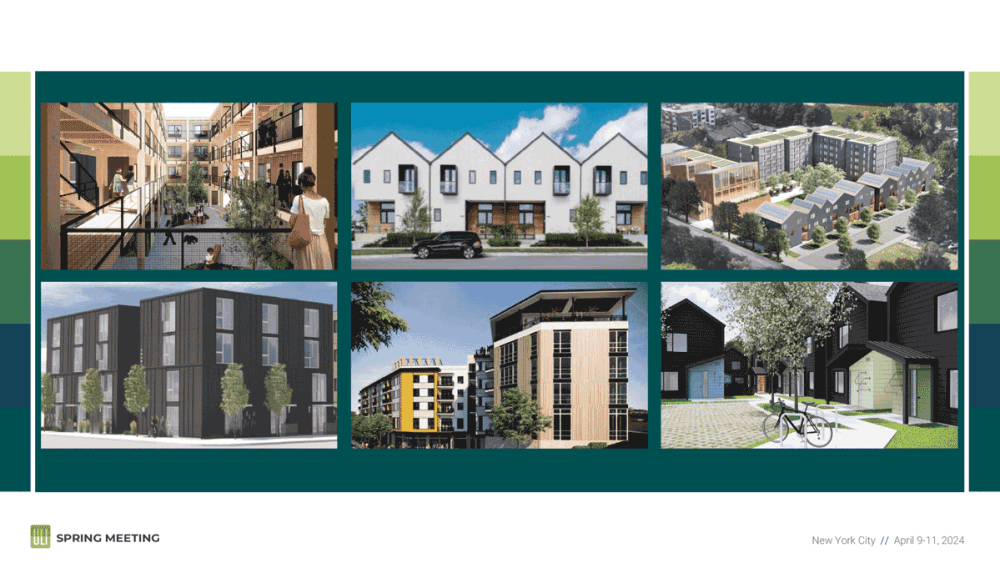It’s possible to build new apartments that are affordable to middle-income renters—but it’s rarely easy.
Developers of middle-income projects still can’t use subsidy programs such as federal low-income housing tax credits (LIHTCs) to finance their plans. Middle-income developments also often don’t earn enough in rent to support conventional construction loans or attract conventional equity investors.
“There’s kind of a financing black hole for multifamily housing at this income range,” said Jessy Ledesma, founder and principal of HomeWork Development and codeveloper of Shortstack Housing. Ledesma moderated “Developing ‘Missing Middle’ Housing: Opportunities, Challenges, and Creative Financing Tools,” a session at the 2024 ULI Spring Meeting, held in New York City.
Innovative construction techniques, tax abatements and grants, and new zoning rules are helping to make these deals work.
“We have to get really creative,” Ledesma said.
New zoning rules allow for more housing
Developers in Oregon can now create duplex houses and apartment buildings in many places where—until recently—they were allowed to build only detached, single-family homes.
The unaffordability of housing today is partly the result of restrictive local zoning laws, according to Anyeley Hallova, chair of Oregon’s Land Conservation and Development Commission and the founder of Adre, a development company. Zoning policy in Oregon is set by the state’s Department of Land Conservation and Development (DLCD) and then passed down to towns, cities, and counties to implement, with some flexibility on siting and design requirements. This includes the policy on Housing Choice implemented through House Bill 2001 in 2019, which allows for missing middle housing in formerly zoned single-family zones.
Homes built using these zoning policies won’t necessarily have restricted rents. But simply allowing more homes to be built should help ease the housing shortage that has pushed the price of housing higher and higher. Without a shortage of housing, the price of existing housing units naturally declines as they get older.
“The market rate housing of today is the affordable housing of the future,” Hallova said.
In the meantime, Hallova’s development firm is planning to build 20 attached, for-sale homes on a donated site in Portland, Oregon, at its Williams & Russell Project. The homes are expected to sell for between $200,000 and $550,000 apiece, which should be affordable to buyers earning between 60 percent and 120 percent of AMI. Adre is now putting together the financing for the $16.9 million project, including millions of dollars in grants that have already been committed. Construction should be complete by June 2026.
Tax breaks make the difference
Local officials can also help by offering a break on property taxes to developers who plan to build middle-income housing.
Half of the 219 new apartments will be affordable to renters earning up to 80 percent of AMI at Oakhouse, a new apartment building now under construction in the North Oak Cliff neighborhood of Dallas, Texas. The rest of the apartments will rent at market rates.
“In this case, the tax exemption was enough to make it work,” said Andrea Wenner, director of investor relations and strategic partnerships for MSquared.
New construction techniques make housing less expensive
Developers are also using new building techniques to create housing that middle-income renters can afford.
Four projects now underway in Portland are using Shortstack, an innovative system of housing components factory made of engineered wood. The components can be stacked to create cottage developments or apartment buildings up to four stories tall, with standardized unit types that use their sites as efficiently as possible.
“We’re building three- and four-story multifamily projects, and little cottages, really quickly, using mass timber,” said Anna Mackay, cofounder of Shortstack. Mackay is also the founder and principal of Sister City, a development firm using Shortstack in Portland. “All of our units are always the same, but you can stack them in different ways, depending on what the lot needs.”
With Shortstack, housing can be built in Portland for an average of $380,000 per unit, according to Mackay. That’s a huge discount, compared to an average development cost of $420,000 per unit for new market-rate podium apartments, $490,000 for new apartments subsidized with LIHTCs and $510,000 for new market-rate townhouses.
It also helps that Sister City designed its apartments to be as efficient as possible.
“One of the ways we’re able to deliver these [structures] at a lower price point is that there isn’t a gym and a lobby and a door person,” Mackay said. “These are beautiful homes, it’s beautifully landscaped, but it’s not necessarily a full-package multifamily project.”







